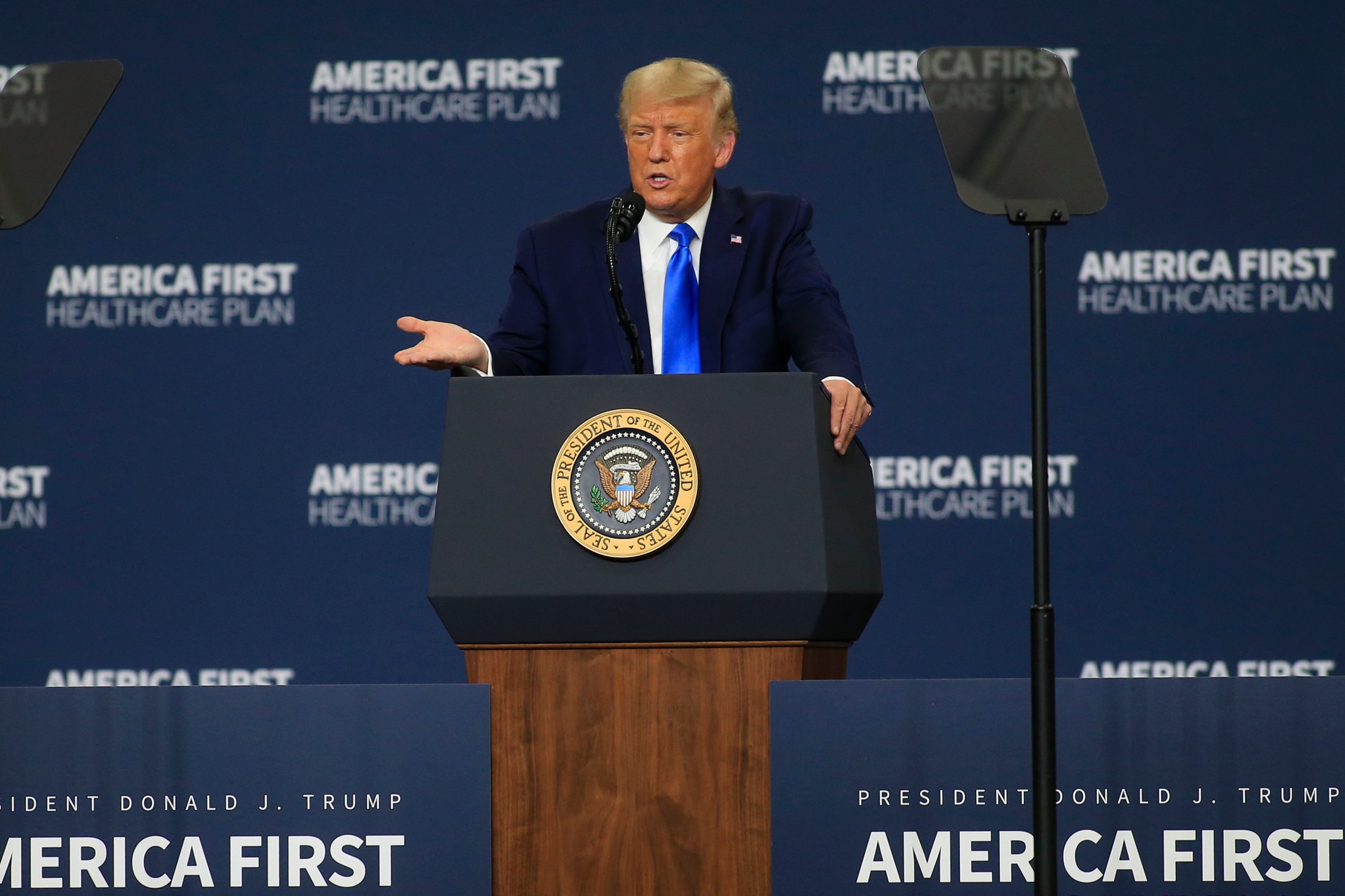
President Donald Trump, who has long promised a “beautiful” and “phenomenal” health care plan, announced a series of largely meaningless actions on Thursday during a speech in North Carolina that effectively served as a campaign event.
The most tangible proposal Trump unveiled was a vow to send $200 prescription drug discount cards to 33 million Medicare beneficiaries “in the coming weeks.” However, the President said the $6.6 billion outlay needed to fund this program would have to come from savings from his “most favored nations” drug pricing proposal, which he announced on Sept. 13, and which experts say would be close to impossible to implement before the November election.
The Trump Administration recently tried and failed to convince the pharmaceutical industry to fund a similar plan, according to the New York Times. It’s unclear if the version announced Thursday will see a different fate.
Trump also announced two non-binding executive orders on Thursday, one addressing the topic of surprise out-of-network medical bills and the other addressing the topic of protecting pre-existing conditions. These are two of Americans’ biggest complaints with the country’s health care system. But neither of these orders will have any immediate effect on the problem at hand.
The first non-binding executive order is simply a promise. It declares that “it is the policy of the United States that people who suffer from pre-existing conditions will be protected,” Health and Human Services Secretary Alex Azar said on a press call with reporters before Trump’s speech. This does not create a policy or a law. Administration officials and the President himself said this would cover the same protections already established under the Affordable Care Act (ACA)—the health care law passed by former President Barack Obama, which the Trump Administration is currently trying to overturn in court.
The U.S. Supreme Court is set to hear a challenge to the ACA on Nov. 10, one week after Election Day. If the High Court overturns the law, the American health care system would be sent into chaos. (That prospect is now more likely since Justice Ruth Bader Ginsburg has died and Trump has vowed to appoint a new judge to replace her as soon as possible.) The protections for those with pre-existing conditions that Trump is touting would evaporate, tens of millions of Americans would lose health insurance coverage and the current system of insurance marketplaces would disappear. Health care and legal experts noted that it’s unlikely the White House could put in place similar protections for people with pre-existing conditions without passing a law through Congress.
Trump, though, did not seem deterred. He told the often-cheering audience on Thursday that he was glad his Administration has been able to keep the ACA’s protections for pre-existing conditions even as Republicans successfully eliminated other provisions, like the so-called individual mandate. “We were able to terminate the individual mandate, but kept the provision protecting patients with pre-existing conditions,” Trump said.
This statement likely made the Trump Administration’s own Department of Justice (DOJ) lawyers squirm. In the current ACA case before the Supreme Court, DOJ lawyers are backing an argument that is at odds with the President’s words—that the Justices must find the entire ACA no longer constitutional since the individual mandate is no longer in effect.
And while Trump has often talked about protecting people with pre-existing conditions, his Administration has repeatedly taken actions that would have the opposite effect. The Administration has supported Congressional Republicans’ many attempts to repeal the ACA, which would eliminate protections for those with pre-existing conditions, and it championed cheaper, skimpier health insurance plans that allow insurers to deny coverage to those with pre-existing conditions.
The second non-binding executive order also does not commit Trump to taking action. Rather, it directs Azar to work with Congress to ban surprise out-of-network medical bills. If Congress does not pass legislation by Jan. 1, Azar told reporters, then Trump will direct him to take other actions. (Azar said he did not have other details on what those actions would be.)
Trump’s announcements Thursday failed to match his pledge of a “full and complete” health care plan. They also failed to make good on senior officials’ claims, made on the press call just ahead of Trump’s speech Thursday, that the President would present an “historic” proposal. But none of this came as much of a surprise to those in Washington or in the health care industry. Trump’s speech, less than six weeks before an election in which he’s trailing former Vice President Joe Biden in most polls, was widely viewed as another attempt to change the national conversation.
Trump is particularly lagging behind Biden on most health care issues, and surveys show that most Americans still disapprove of the President’s handling of the coronavirus pandemic. A new survey released by the Commonwealth Fund on Thursday found that the majority of likely voters in 10 battleground states said Biden is more likely to protect insurance coverage for pre-existing conditions. And a poll by the nonpartisan Kaiser Family Foundation this month found that the majority of voters trust Biden over Trump on a variety of health care issues, with the President only leading narrowly on prescription drug prices.
Trump’s top advisers, while striking an upbeat note before his event in North Carolina, demurred when asked for the details on how the President’s new plans would become reality. “It is what it is,” Azar said.
More Must-Reads from TIME
- Why Biden Dropped Out
- Ukraine’s Plan to Survive Trump
- The Rise of a New Kind of Parenting Guru
- The Chaos and Commotion of the RNC in Photos
- Why We All Have a Stake in Twisters’ Success
- 8 Eating Habits That Actually Improve Your Sleep
- Welcome to the Noah Lyles Olympics
- Get Our Paris Olympics Newsletter in Your Inbox
Write to Abigail Abrams at abigail.abrams@time.com
